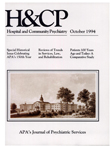A Psychiatric Hospital 100 Years Ago: II. Patients, Treatment, and Daily Life
Abstract
Data from archival sources were used to determine the kinds of patients treated at the St. Louis City (later St. Louis County) Insane Asylum, the treatments they received, activities of daily life in the asylum, and political factors affecting operation of the asylum in the late 19th and early 20th centuries. Data from patient records, journal and newspaper articles, and annual reports of asylum superintendents from the period were analyzed. The authors conclude that although much has changed in the operation of public psychiatric hospitals in the past 100 years, some themes, including inappropriate referrals of forensic cases to psychiatric hospitals, problems of discharging long-stay patients, and the media's tendency to sensationalize events and conditions in hospitals, remain the same.
Access content
To read the fulltext, please use one of the options below to sign in or purchase access.- Personal login
- Institutional Login
- Sign in via OpenAthens
- Register for access
-
Please login/register if you wish to pair your device and check access availability.
Not a subscriber?
PsychiatryOnline subscription options offer access to the DSM-5 library, books, journals, CME, and patient resources. This all-in-one virtual library provides psychiatrists and mental health professionals with key resources for diagnosis, treatment, research, and professional development.
Need more help? PsychiatryOnline Customer Service may be reached by emailing [email protected] or by calling 800-368-5777 (in the U.S.) or 703-907-7322 (outside the U.S.).



